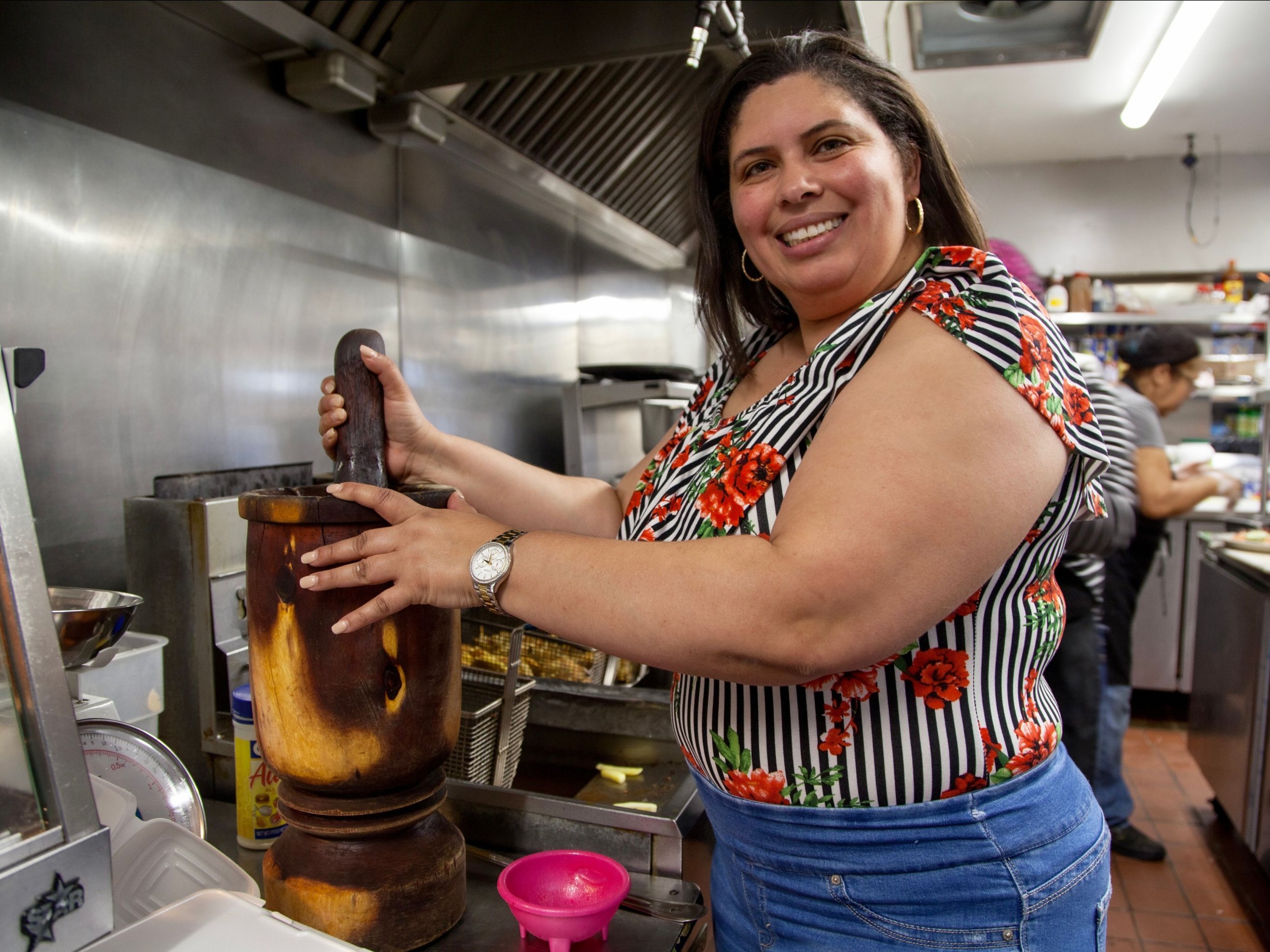This is New Hampshire: Exploring Diversity in the Granite State
By Nour Habib, Granite State News Collaborative Engagement Reporter
Good morning, and welcome to the another installment of This is New Hampshire, the Collaborative's newsletter focused on our race and equity project.
It's been a busy month and there's plenty to share, but first, a request: Solutions Journalism Network, which has provided funding and other support for our work, is conducting research on the impact of collaborative news organizations like ours. If you could take five minutes to complete this survey in English or Spanish, it would help them (and us) gauge the impact of our work.
Now, a look at this work: This month, we released our College Diversity Series, which has been in the making since the beginning of the year. The Collaborative worked with our partners at the New Hampshire Press Association to develop teams of student journalists to explore issues of diversity on the state’s college campuses. Their reporting found that NH colleges have struggled to meet their own diversity goals, and they often face a tough sell in their bid for minority students. Click here to read more about the project, and all the stories in the series, and check out the Q&A with the student journalists further in this newsletter.
TELL US: What is your experience with diversity on New Hampshire college campuses? And do you have ideas for what our next cohort of student journalists should explore in their reporting? Email me at nour.habib@collaborativenh.org with your thoughts.
Check out the video below from New Hampshire PBS's The State We're In to meet the students behind the project.
We've also continued to cover the policies banning what have become known as "divisive concepts," after they became law when the governor signed off on them as part of the budget in late June. This coverage includes a story on half the governor's diversity council resigning in response to the passage of these policies, as well as a piece on Granite Staters awaiting guidance on what the new policies will actually mean on the ground.
In other news: The Collaborative was awarded a $50,000 grant from the New Hampshire Charitable Foundation. The grant will fund the reporting and management of our race and equity project. For more information, click here.
Also this month, the Collaborative held a virtual listening session with members of the community focused on our race and equity project. We received excellent input around our education, criminal justice and economic opportunity topic areas, and our editors and reporters look forward to pursuing the ideas that were discussed. Throughout the course of the project, we will hold additional listening sessions in various formats to make sure that the initiative is truly community-driven. Please reach out to me if you would like to attend one of these sessions.
Below: In this edition of the newsletter we introduce our first Legislative Corner feature from Statehouse Reporter Jenny Whidden. This month she'll focus on legislation around affordable housing.
And finally, a great new series from our partners at NHPR and FirstGen MultiMedia called "The Flavors of our Neighbors."
Three Questions with our College Diversity Series student journalists
Four student journalists worked with the Collaborative and the New Hampshire Press Association to report on diversity on New Hampshire college campuses. Pictured above, clockwise from top left, are Alena Masterson from Franklin Pierce University, Evan Edmonds from the University of New Hampshire, Kenneth Tran from Saint Anselm College and Sofia El Hakim from Keene State University.
1. What was your biggest takeaway from this project?
Sofia: I really understood how diversity is so important on campus, especially for students of color. I never realized that without affinity groups, students are not given the opportunity to meet students who identify similarly to themselves.
Evan: My biggest takeaway from the project focusing on SNHU was that even though universities champion diversity, there is still lots of real work to be done to ensure that diversity is had in these schools. There's some to a degree, but the real work comes into play when we want to make it more than just 'some diversity.'
2. What would you say are the benefits to having a diverse student body on college campuses?
Kenneth: Diverse student bodies also bring diverse thought and backgrounds into a school's classrooms. Diversity on college campuses has proven over and over again to benefit education outcomes and foster a better sense of inclusion for all students.
Alena: The benefits of having a diverse student body are the numerous experiences and engagement that all students can benefit from. The intellectual, social and cultural engagement is a crucial part in the development of self-awareness. This can work in tandem with a student academic career as they learn to critically think about the world around them when problem solving and moving forward in their chosen profession.
3. In your view, either from personal experience or through the reporting you've done, what is the biggest challenge of being a student of color at a New Hampshire university?
Kenneth: The biggest challenge from being a student of color from my own personal experience and from my reporting in New Hampshire is that in most cases, it is incredibly difficult to feel included because wherever you walk on campus, you do not see a single face that looks like you. It's disappointing that students of color are excited to see other students of color because it displays how non-diverse a campus is in everyday college life.
Alena: From my experience and reporting I think the biggest challenge is not having people like you around. This can make it feel hard to connect or feel like you belong within the community. In particular, I have also seen in the classroom not a lot of materials covered or provided are from the perspectives of scholars from minorities. Thus further limiting a student of color seeing themselves in the lessons being taught or a part of the community of the institution.
Legislative Corner
By Jenny Whidden, Granite State News Collaborative
With the state legislature adjourned until January, I’ve been taking this time to look back at what our representatives worked on these past several months — namely affordable and workforce housing.
The state’s ongoing housing crisis, a deeply complex issue, has long been a hot topic at the state level, but legislators say that at its heart, affordable housing is a local issue. That’s because it’s so reliant on municipal zoning, in which towns and cities divide land into different areas that have varying sets of regulations. It’s these zones that often either allow, encourage or impede affordable housing.
As a result, the bills that move through the state legislature are often aimed at encouraging municipalities to in turn encourage affordable and workforce housing. This is done through things like tax incentives and preferential access to state resources.
For instance, House Bill 586 was aimed at making changes to different systems and tax credits to encourage workforce development, such as shortening the appeals process for zoning board decisions and expanding the community revitalization tax credit period to up to 13 years.
The bill had bipartisan backing among lawmakers but was ultimately tabled in the House by just three votes amid concerns that it would shift costs to local boards and override the zoning processes that communities already have in place.
The legislation’s sponsor, Rep. Joe Alexander Jr. (R-Hillsborough), said the bill could be introduced again next year, but plans to go in a different direction are in the works.
Alexander said a key part of the housing issue moving forward will be education for municipalities and local officials. He wants to get the word out that many of the bills introduced in the legislature, including HB 586, are designed to support municipalities, but they’re not mandatory.
“They’re opt-in,” he said. “Municipalities that want to do more, we’ll have resources for them."
Alexander added that he frames the issue as workforce housing rather than affordable housing — “We’re talking about having our current workforce being able to live and work in the state,” he said.
Housing authorities typically define workforce housing as homes aimed at households earning from 60 percent to 120 percent of the area’s median income (AMI), while affordable housing is generally used for households whose income is less than 60 percent of the AMI. However, the two terms are often used interchangeably.
Alexander’s comment reminded me of a June article in Business NH Magazine that touched on the negative stereotypes about affordable housing, and how they’re one of the many roadblocks to such development.
I plan to continue keeping an eye on affordable and workforce housing legislation in New Hampshire, especially how it intersects with race and equity. In the meantime, what do you think about the housing issue in the Granite State? Have you struggled to find housing that meets your budget? Do the terms affordable and workforce housing leave you with different impressions? How would you feel about affordable housing being developed in your municipality?
If you’d like to share your thoughts, I’d love to hear them at jenny.whidden@collaborativenh.org.
To read more about affordable and workforce housing, and a bill that did become law, click here.
From our partners
Sandra Almonte, owner of Don Quijote, prepares a mofongo using a pestle.
CREDIT GABRIELA LOZADA / NHPR
Nearly 10 percent of restaurants across the country have permanently closed in the past year due to many challenges. Owners have found ways to innovate and adapt during this time, not only because of what it meant to their livelihoods, but what their restaurants mean to their communities. NHPR and the partners of the Granite State News Collaborative, in collaboration with leaders of Latino communities in the state, developed a project called "The Flavors of Our Neighbors," highlighting Latino restaurant owners who have weathered, thrived and continued to provide a sense of home for their customers and communities over the past year. You can read or listen to the first two installments of the series here and here.
Thanks for reading! See you next time. -- Nour
P.S. Feel free to forward our subscription link to anyone who you think might be interested in receiving this newsletter.
ABOUT THE GRANITE STATE NEWS COLLABORATIVE
The Granite State News Collaborative is a collective of about 20 local media, education and community partners working together to produce and share news stories on the issues that most impact our state. Together we can provide more information to more communities across New Hampshire than we could individually.






